 |
 |
Aesthetic, light, and strong, suspension bridges can span distances from 2,000 to 7,000 feet—far longer than any other kind of bridge. They also tend to be the most expensive to build. True to its name, a suspension bridge suspends the roadway from huge main cables, which extend from one end of the bridge to the other. These cables rest on top of high towers and are secured at each end by anchorages.
Try It! What are the anchorages for?  Next, stand two books about 10 inches apart. Put a stack of heavy books on one
end of string to secure it to the table. Then pass the string over each book
(letting some string hang loosely between the books). Place a second stack of
books on the other end of the string. Press again on the center of the string.
What happens? Notice how the anchorages (stacks of books) help to stabilize the
bridge.
Next, stand two books about 10 inches apart. Put a stack of heavy books on one
end of string to secure it to the table. Then pass the string over each book
(letting some string hang loosely between the books). Place a second stack of
books on the other end of the string. Press again on the center of the string.
What happens? Notice how the anchorages (stacks of books) help to stabilize the
bridge.
Rope made from bamboo, itself a form of grass, was used to hang the Anlan suspension bridge in China, first constructed about A.D. 300. The bridge spans the 1,000-foot wide Min River, using piers that support eight sections of cable to do so.
Today, suspension bridge cables are made of thousands of individual steel wires bound tightly together. Steel, which is very strong under tension, is an ideal material for cables; a single steel wire, only 0.1 inch thick, can support over half a ton without breaking.
You'll need one of the (free) software plugins—RealPlayer or QuickTime—to be able to view the video clips of the Tacoma Narrows bridge. If you already have the software, choose an appropriate connection speed (RealVideo) or the file size (QuickTime, AVI) to view a clip.At the time it opened for traffic in 1940, the Tacoma Narrows Bridge was the third longest suspension bridge in the world. It was promptly nicknamed "Galloping Gertie," due to its behavior in wind. Not only did the deck sway sideways, but vertical undulations also appeared in quite moderate winds. Drivers of cars reported that vehicles ahead of them would completely disappear and reappear from view several times as they crossed the bridge. Attempts were made to stabilize the structure with cables and hydraulic buffers, but they were unsuccessful. On November 7, 1940, only four months after it opened, the Tacoma Narrows Bridge collapsed in a wind of 42 mph—even though the structure was designed to withstand winds of up to 120 mph.
Today, wind tunnel testing of bridge designs is mandatory. As for the Tacoma Narrows bridge, reconstruction began in 1949. The new bridge is wider, has deep stiffening trusses under the roadway and even sports a slender gap down the middle—all to dampen the effect of the wind. back to intro next bridge description: cable-stayed Photos: (1) © Mark E. Gibson/Visuals Unlimited; (2,3) Matsuo Bridge Co., Ltd.; (4) NOVA/WGBH; (5) Richmond and Rigg Photography; (6,7) Ed Elliot/The Camera Shop; (8) Corbis-Bettmann. NOVA Builds a Rainbow Bridge | Bridge the Gap | Nature's Miracle Material China's Age of Invention | Resources | Transcript Medieval Siege | Pharaoh's Obelisk | Easter Island | Roman Bath | China Bridge | Site Map Editor's Picks | Previous Sites | Join Us/E-mail | TV/Web Schedule About NOVA | Teachers | Site Map | Shop | Jobs | Search | To print PBS Online | NOVA Online | WGBH © | Updated November 2000 |
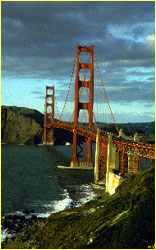 Suspension bridge
Suspension bridge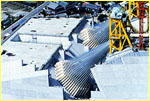 Suspension bridge anchorage
Suspension bridge anchorage
 People have walked across the Anlan Bridge for 1,700 years.
People have walked across the Anlan Bridge for 1,700 years.
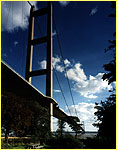 The Humber bridge
The Humber bridge
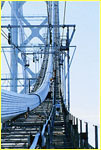 Akashi bridge cable assembly
Akashi bridge cable assembly


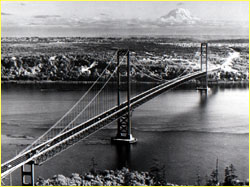 New Tacoma Narrows Bridge
New Tacoma Narrows Bridge